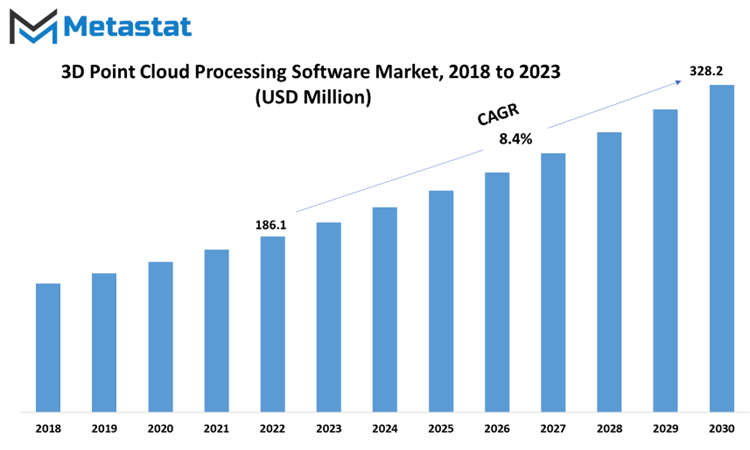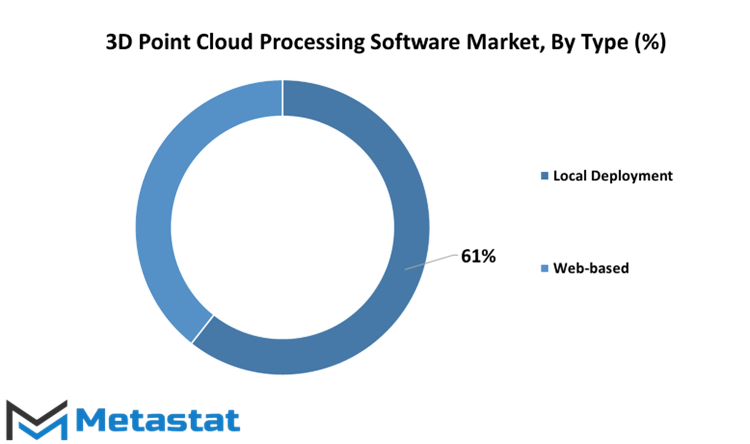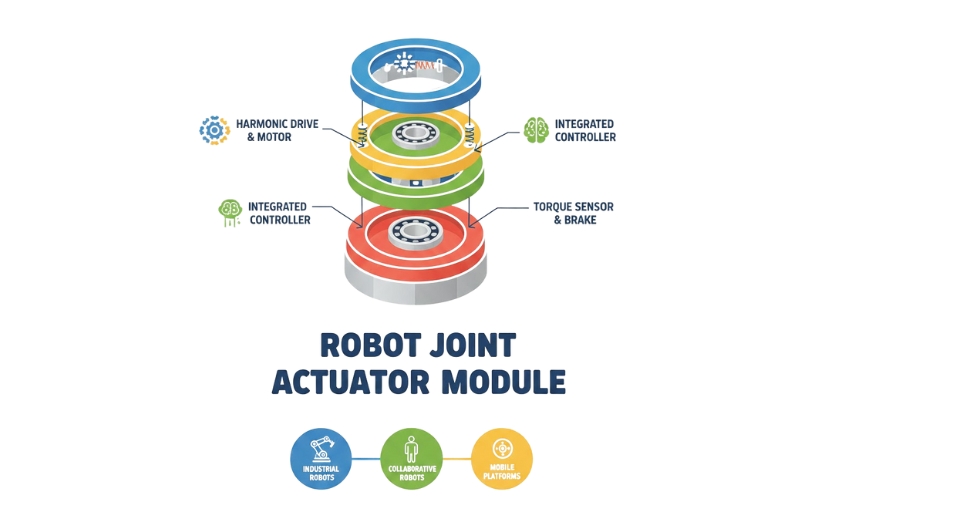MARKET OVERVIEW
The Global 3D Point Cloud Processing Software Market is a catalyst for change in a multitude of industries, from construction and urban planning to archaeology and autonomous vehicles. Understanding the essence and implications of the 3D Point Cloud Processing Software Market is vital, as it shapes the digital spatial processing landscape. This software not only provides a dynamic interface for processing vast quantities of 3D spatial data but also opens an array of applications in diverse fields such as geospatial analysis, autonomous vehicles, urban planning, and more. This essay delves into the multifaceted landscape of global 3D point cloud processing software, highlighting its role in addressing complex data processing challenges, its applications across industries, and the overarching impact on our modern world.
At its core, 3D point cloud processing software is an invaluable tool for rendering a three-dimensional representation of real-world environments. It functions by collecting data from laser scanners, LiDAR systems, or photogrammetry, converting these measurements into a cloud of 3D points. The software then engages in a series of intricate algorithms that clean, filter, and manipulate this data to generate comprehensive 3D models. In the ever-evolving landscape of technology, the software's capability to handle massive datasets swiftly and efficiently is crucial.
In a technology-driven era, global 3D point cloud processing software stands as a testament to human ingenuity and its power to transform industries. It is not just a tool for data processing; it is a bridge to a future were spatial data reigns supreme. Its myriad applications and transformative influence in diverse sectors underscore its indispensable role in shaping the way we perceive and interact with our world. As this software continues to evolve, its importance will only grow, making it an essential asset for the present and the key to unlocking the innovations of the future.
Global 3D Point Cloud Processing Software market is estimated to reach $328.2 Million by 2030; growing at a CAGR of 8.4% from 2023 to 2030.

GROWTH FACTORS
The 3D Point Cloud Processing Software market is a dynamic space, influenced by various factors that shape its trajectory. In this discussion, we will unravel the drivers, restraints, and opportunities that define this market.
One of the key drivers in the 3D Point Cloud Processing Software market is the rising demand for automation. Industries have come to realize the potential of automating the intricate processing of 3D point cloud data. This surge in automation aligns with the broader trend of digital transformation, a defining feature of our technological era. Automation not only enhances operational efficiency but also reduces manual effort and streamlines workflows. In sectors such as construction, architecture, manufacturing, and transportation, where managing 3D point cloud data is complex and time-consuming, automation eliminates errors, improves accuracy, and accelerates decision-making. This demand for automation ensures that industries remain competitive in an environment marked by technological evolution.
Advancements in sensing technology also play a pivotal role in driving the 3D Point Cloud Processing Software market. Continuous improvements in LiDAR and laser scanning technologies have revolutionized data acquisition. These advancements enable the collection of intricate 3D point cloud data with unprecedented precision. However, the sheer volume and complexity of this data poses a challenge in terms of efficient processing and extraction of meaningful insights. Hence, there's a growing need for sophisticated 3D Point Cloud Processing Software. These software solutions handle data registration, feature extraction, object recognition, and spatial analysis, allowing businesses to unlock the full potential of advanced sensing technologies. This symbiotic relationship between technological innovation and software development ensures that as sensing technology continues to evolve, so does the demand for sophisticated software solutions.
While there are several drivers propelling the market forward, certain restraints also warrant consideration. Complex data handling is a significant constraint in the 3D Point Cloud Processing Software market. Processing large and intricate point cloud datasets is computationally intensive and requires specialized skills. The intricacies of point cloud data demand complex algorithms and data structures for efficient processing, extending processing times and posing scalability issues. The specialized skill set required adds to the constraint by limiting the availability of qualified personnel. The challenges of handling point cloud data also translate into higher costs, both in terms of human resources and hardware infrastructure. However, these challenges also drive innovation within the market, leading to the development of advanced algorithms and user-friendly tools that facilitate efficient data handling.
Cost of implementation is another notable restraint. High-end point cloud processing software often comes with substantial costs, making it less accessible, particularly for smaller businesses operating with limited budgets. The advanced nature of this software and the expertise required for its development contribute to higher costs. Smaller businesses may find the cost of implementation to be a formidable barrier, extending to hardware infrastructure, training, and ongoing support. However, the industry is responsive to this challenge and is exploring innovative pricing models, subscription-based options, and tailored solutions to make these tools more accessible.
Amidst these drivers and restraints, there are intriguing market opportunities to consider. An exciting one lies in the integration of 3D point cloud processing software with Building Information Modeling (BIM) systems. This integration offers enhanced accuracy and visualization in construction and architecture, combining the strengths of 3D point cloud data and BIM systems. It facilitates precise planning, design, and collaboration by providing unprecedented levels of detail and fidelity. The technology helps identify potential issues, streamlines the construction process, and ensures project documentation remains up to date. As industries continue their digital transformation journey, this integration is poised for substantial growth, facilitating predictive analytics, simulations, and optimizations that drive innovation and efficiency. This integration serves as an example of the collaborative potential of technology solutions when harnessed for a common purpose, offering transformative possibilities in construction and architecture.
In conclusion, the 3D Point Cloud Processing Software market is a dynamic landscape shaped by the interplay of drivers, restraints, and opportunities. The demand for automation and advancements in sensing technology drive the market forward, while challenges related to complex data handling and implementation costs necessitate innovative solutions. The integration of 3D point cloud processing software with BIM systems represents a promising avenue for future growth, underlining the market's potential to adapt and thrive in an ever-evolving technological landscape.
MARKET SEGMENTATION
By Type
The 3D Point Cloud Processing Software Market, a technological realm of growing importance, is witnessing remarkable advancements in recent years. In this context, the market's segmentation by type has gained considerable significance. This segmentation bifurcates the 3D Point Cloud Processing Software Market into two key categories. The Local Deployment segment, a robust contender in this market, demonstrated its worth by amassing a valuation of 106.8 million USD in 2022. This segment is known for its reliability and robustness, making it a preferred choice for many users.
On the other hand, the Web-based segment, although valued at 68.8 million USD in 2022, holds its own significance. It offers the advantage of accessibility from any location with an internet connection, making it a flexible choice for those who value mobility and online collaboration.
This duality within the 3D Point Cloud Processing Software Market's segmentation offers users the freedom to choose between two distinct yet valuable approaches. The choice between local deployment and web-based software hinges on factors such as individual preferences, organizational requirements, and practical considerations.
The market continues to witness the evolution of both local deployment and web-based solutions, reflecting the ever-changing landscape of technology. As these segments adapt and improve, users can expect even greater efficiency and functionality from 3D Point Cloud Processing Software in the years to come. This ongoing development ensures that users have a wide array of options to suit their specific needs, making the 3D Point Cloud Processing Software Market a dynamic and responsive industry in the tech landscape.

By Application
The 3D Point Cloud Processing Software Market is a dynamic landscape driven by various applications, with each segment holding distinct value. In 2022, the Architecture segment was valued at 74 million USD. This highlights the significance of 3D point cloud processing software in architectural applications, where it aids in tasks like modeling and creating digital replicas of physical structures.
Land Survey, another significant segment, accounted for a value of 30.5 million USD in 2022. This underscores the software's role in land surveying, where it facilitates the accurate measurement and mapping of terrains and landscapes.
Furthermore, the Forestry segment, valued at 12.5 million USD in 2022, showcases how this software contributes to the forestry industry by assisting in tasks such as forest inventory and environmental monitoring.
In the context of Mines and Quarries, the software segment was valued at 25.6 million USD in 2022. This indicates the software's pivotal role in tasks like geological mapping and mineral exploration in these sectors. The others segment, with a value of 33 million USD in 2022, signifies a broader range of applications where 3D point cloud processing software is put to use.
These segments collectively emphasize the versatile applications of 3D point cloud processing software across various industries, underlining its growing importance in an array of fields.
REGIONAL ANALYSIS
The global 3D Point Cloud Processing Software market is a dynamic landscape with various regions contributing significantly to its growth. Among these, North America and Europe stand out as key players in this market.
In North America, the 3D Point Cloud Processing Software market has made substantial strides. It was estimated to be valued at 56.1 USD Million in 2018. This valuation reflects the region's strong presence and investment in technology and software development. North America's advanced infrastructure and research and development efforts have propelled its growth in this market.
Similarly, Europe has also played a significant role in the 3D Point Cloud Processing Software market. The estimated value of the market in Europe was 52.1 USD Million in 2018. The region's emphasis on innovation and technology adoption has driven this growth. European countries have shown a remarkable affinity for integrating 3D Point Cloud Processing Software into various sectors, including architecture, construction, and geospatial applications.
Both North America and Europe are witnessing a surge in demand for 3D Point Cloud Processing Software due to its versatility and applications across diverse industries. These regions continue to invest in research and development, ensuring that they remain at the forefront of technology. The 3D Point Cloud Processing Software market in these regions is not just a reflection of their present market value but also a testament to their commitment to technological advancement and innovation.
COMPETITIVE PLAYERS
The 3D Point Cloud Processing Software market, a field of technology that's gained traction in recent years, is witnessing significant growth and innovation. This market revolves around the processing and analysis of 3D point cloud data, which is collected from various sources like LiDAR (Light Detection and Ranging) scanners and photogrammetry.
Key players driving advancements in the 3D Point Cloud Processing Software industry include FARO and PointCab GmbH. These companies have established themselves as frontrunners, providing cutting-edge solutions for processing and interpreting vast point cloud datasets.
FARO, a prominent name in the industry, offers a range of software solutions that enable professionals to efficiently manage and analyze 3D point cloud data. These tools have applications in diverse fields, from construction and architecture to industrial design and forensics. FARO's software empowers users to extract valuable insights from point cloud information, aiding in decision-making and problem-solving.
PointCab GmbH is another significant player in the 3D Point Cloud Processing Software market. The company specializes in software that simplifies point cloud processing, making it more accessible and practical for a wider range of professionals. PointCab's solutions are known for their user-friendly interfaces and comprehensive features, catering to the needs of industries such as surveying, building documentation, and infrastructure planning.
The growth of these key players highlights the increasing demand for 3D point cloud processing solutions across various sectors. As technology continues to advance, and as these companies drive innovation in the field, we can expect further developments and enhancements in 3D Point Cloud Processing Software, ultimately benefiting professionals and industries that rely on precise and data-rich 3D models.
3D Point Cloud Processing Software Market Key Segments:
By Type
- Local Deployment
- Web-based
By Application
- Architecture
- Land Survey
- Forestry
- Mines and Quarries
- Others
Key Global 3D Point Cloud Processing Software Industry Players
- FARO
- PointCab GmbH
- Autodesk
- Leica Geosystems AG
- RIEGL
- Orbit GT
- Bentley System
- Laserdata GmbH
- Trimble
- TerraSolid
- Geo-Plus
WHAT REPORT PROVIDES
- Full in-depth analysis of the parent Industry
- Important changes in market and its dynamics
- Segmentation details of the market
- Former, on-going, and projected market analysis in terms of volume and value
- Assessment of niche industry developments
- Market share analysis
- Key strategies of major players
- Emerging segments and regional growth potential








 US: +1 3023308252
US: +1 3023308252






